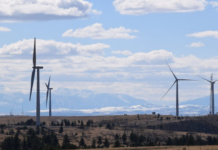GE Renewable Energy has been selected to provide turbines for a giant 1.2 GW wind facility in Aragon, Spain.
The Forestalia Group, through the Sociedad Aragonesa Transeuropea de Energias Renovables, was awarded a contract by Spain’s Ministry of Energy, Tourism and Digital Agenda to develop the project.
Forestalia won the contract in Spain’s renewable energy auction, which, according to WindEurope, awarded nearly 3 GW of wind projects at a price of EUR 43/MWh – “the maximum discount rate allowed under the Spanish tendering system” and “the lowest level ever awarded in an onshore wind tender in Europe,” says WindEurope.
This contract builds on a tender that Forestalia won in January 2016 to develop 408.5 MW of wind farms and bioenergy stations in Aragon. The two contracts support Forestalia’s goal to boost wind energy production in the autonomous community, as well as bring renewable energy generation to an efficient, open and competitive market, GE says in a press release.
GE Renewable Energy will be supplying wind turbines from its 3 MW portfolio to generate a total of 1.5 GW between the two contracts.
GE will manufacture the machines across three European facilities, including its Engineering Center of Excellence in Barcelona. The turbines will be manufactured in Salzbergen, Germany, and the blades will be produced by LM Wind Power, which was recently acquired by GE Renewable Energy and has production plants in Ponferrada and Castellon, Spain. The project will be supported by GE’s service center in As Pontes, Spain.
“We are very pleased to be closely collaborating with Forestalia on a project that will drive renewable energy growth and cost-competitiveness in Europe,’ comments Jérôme Pécresse, president and CEO of GE Renewable Energy. “GE is immensely proud that the turbine that will equip the future farms is a European product with the nacelle produced in Germany, in addition to the towers and blades manufactured in Spain.”
Giles Dickson, CEO of WindEurope, adds, “The tender results show how onshore wind is today the cheapest option for new power generation. Some may think wind energy no longer needs subsidies. But it was the fact the auction offered a guaranteed minimum income that attracted investors and ensured there were enough bids to deliver the low price.”
Further, WindEurope says it “welcomes the results of the Spanish auction as a positive development,” considering there was a “three-year market standstill triggered by retroactive cuts to the Spanish feed-in tariff in 2013.”




